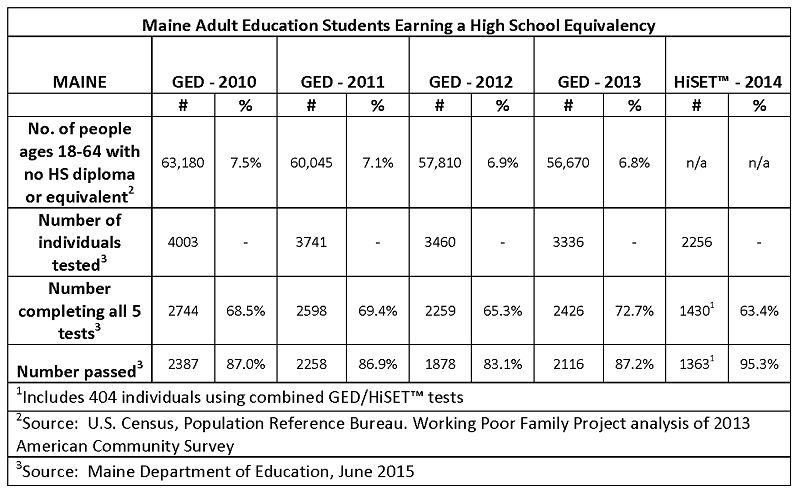Over 400 Mainers who would have been passed over by the traditional GED received their high school diplomas in 2014. That’s 400 more Mainers who now have a better opportunity for a job to support themselves and their families.
It’s because Maine dropped the traditional GED and opted for a new high school equivalency test, Hi-SET™, produced by the nonprofit Educational Testing Service (ETS).
The GED was created for WWII military, many having not graduated because of the call to service.
For 72 years the nonprofit American Council on Education administered the GED and periodically updated the tests. But in 2014, the council privatized the testing service and gave the five tests that comprise the GED a significant overhaul. Because of the new content, the new testing company decided that anyone who had taken one or more of the old GED tests could not count the results towards his or her diploma under the new regime. This would have stranded hundreds of Maine adult students who would now have to re-take tests they already sat for and passed.
The state of Maine decided that it did not want its students to “fall off the GED cliff,” as it was known nationally. It switched to HiSET™, an accredited alternative program whichallowed students to count their previous GED tests toward their credential in 2014.
Across the country, many problems with the GED have surfaced. The test content is harder and designed for college-bound students. Its on-line platform makes it inaccessible to older adults who may have been laid off from mill or factory jobs and do not have computer skills. The test fees doubled and students are required to have a credit card on file.[1] These changes are excluding millions of low-income adults looking for a better job.
There have also been dramatic drops in the number of people taking the GED test and passing it. According to the GED Testing Service, there was a 90 percent drop in passing rates in 2014 over the year before — though part of the reason is that far fewer people are taking it.
Maine’s numbers have fallen too. Fewer people took a test in 2014, the continuation of a 4-year trend.
The Maine Department of Education attributes some of the decline in 2014 to introduction of the new test. Test sites didn’t open until March. There were no test takers in the pipeline from previous years as is the past. Others scrambled to finish their GED in 2013 before the switch.[2]
Maine’s HiSET™ pass rate at 95.3% in 2015 is stellar. Hardworking Maine adult educators make sure every student is ready to take the test with practice tests and by working with each student one-on-one.
Maine has a good track record with credentialing high school students. The state ranks 4th in the country with the number of people with a diploma and the number of Maine adults without a diploma is decreasing.[3]
But policymakers should monitor the people taking the HiSET™ equivalency tests to determine whether a policy intervention is needed to boost the number of test takers, and ultimately the number of Maine adults with a high school equivalency. Education is the key to a better job, economic security, and prosperity for workers and their families. A high school diploma is an important step on the road to success.
[1] Fortunately, in Maine, the state pays 100% of the cost of Maine students taking the GED relieving adult students of this burden.
[2] Heath, Kelly. High School Equivalency/Data Coordinator,Maine Department of Education. E-mail, June 26, 2015.
[3] U.S. Census, Population Reference Bureau. Working Poor Family Project analysis of 2013 American Community Survey data.




